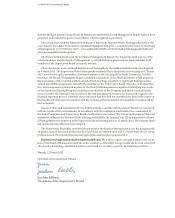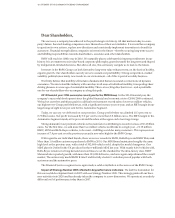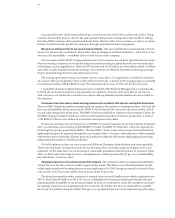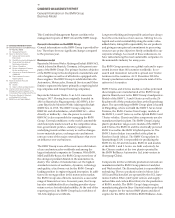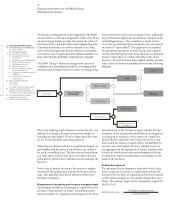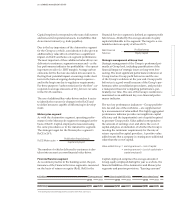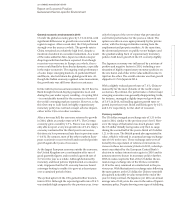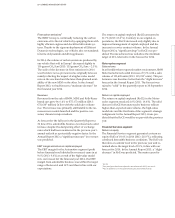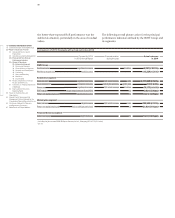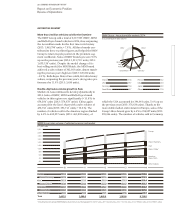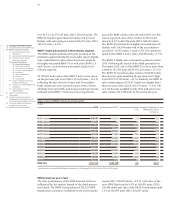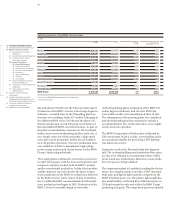BMW 2014 Annual Report Download - page 23
Download and view the complete annual report
Please find page 23 of the 2014 BMW annual report below. You can navigate through the pages in the report by either clicking on the pages listed below, or by using the keyword search tool below to find specific information within the annual report.
23 COMBINED MANAGEMENT REPORT
General economic environment in 2014
Overall, the global economy grew by 3.3 % in 2014, with
significant differences in growth rates recorded from
region to region. After a weak start, the USA performed
strongly over the year as a whole. The growth rate in
China remained at a relatively high level, despite a
moderate slowdown in economic momentum. As a result
of the value added tax hike, Japan recorded a steeper
drop in growth than had been expected. Even though
recession was overcome in Europe as a whole, the
re-
covery could hardly be described as dynamic, especially
in the major economies. The ongoing weak performance
of some major emerging markets, in particular Brazil
and Russia, also held down the global growth rate. Al-
though the Indian economy regained some momentum,
the growth rate was still lower than in recent years.
In line with its previous announcements, the US Reserve
Bank brought its bond-buying programme to an end
during the year under report, resulting – in spring 2014
– in considerable turmoil for the currencies of some of
the world’s emerging market countries. However, so far,
this first step to scale back its highly expansionary
monetary policy has not had a major adverse impact,
either in the USA or in other countries.
After a two-year lull, the eurozone returned to growth
in 2014, albeit at a modest rate of 0.8 %. The German
economy grew overall by 1.5 %. France was once again
only able to report a very low growth rate of 0.4 %. Italy’s
economy contracted for the third year in succession,
this time at a less pronounced rate than in previous years
(–
0.4 %). By contrast, most of the other southern
Euro-
pean economies recovered well and recorded positive
growth again after years of recession.
As the largest European economy outside the eurozone,
the United Kingdom saw a continuation of its run of
good quarterly figures and recorded a growth rate of
2.6 % for the year as a whole. Although bolstered by
monetary and fiscal policies implemented on a massive
scale, it appears that the UK economy has now found
a stronger footing to enable it to grow at a decent pace
over a sustained period of time.
The cyclical upturn in the USA gained further momen-
tum in 2014. Although the reported growth rate of 2.4 %
was similarly high compared to the previous year, it was
only the
impact of the severe winter that prevented an
even better
performance for the year as a whole. The
upturn was driven once again primarily by the private
sector, with the strongest stimulus coming from the
employment and property markets. At the same time,
the downward
pressure on public-sector budgets and
the gradual
scaling back of expansionary monetary
policies held
down growth in the US economy slightly.
The Japanese economy was influenced by a mixture of
positive and negative factors in 2014, including a
con-
tinuation of highly expansionary monetary policies on
the one hand, and a hike in the value added tax rate in
April on the other. The overall outcome was that growth
slipped to 0.3 % in Japan in 2014.
With a slightly reduced growth rate of 7.4 %, China re-
mained
by far the most dynamic of the world’s major
economies. By contrast, the performance of other major
emerging economies was generally disappointing. India,
for instance, managed a slightly improved growth rate
of 5.4 % in 2014, still trailing against growth rates
re-
ported
in previous years. Brazil and Russia grew by 0.2 %
and 0.6 % respectively, not far short of recession.
Currency markets
The US dollar averaged an exchange rate of 1.33 to the
euro in 2014, similar to the previous year’s level. How-
ever, the range of fluctuation was much greater, with
the US dollar initially losing value only then to surge
during the second half of the year to finish at US dollar
1.21 to the euro. The British pound also appreciated in
value, which is reflected in an annual average exchange
rate of 0.81 to the euro. These exchange rates were af-
fected by the expectation of reference interest rate in-
creases in these two currency blocks in 2015, a develop-
ment
exacerbated by the European Central Bank’s
decision to reduce interest rates again in 2014 and its
announcement to loosen its monetary policies further.
With its value coupled to that of the US dollar, the an-
nual average exchange rate of the Chinese renminbi
(8.19 to the euro) remained at a similar level to the pre-
vious year. With fluctuations in exchange rates following
the same pattern as the US dollar, the Chinese renminbi
also gained noticeably in value towards the end of the
year. In sharp contrast, the Japanese yen fell to an annual
average rate of 140 yen to the euro in the wake of
Japan’s
monetary policy. Despite showing some signs of stabilising
Report on Economic Position
General and Sector-specific Environment


